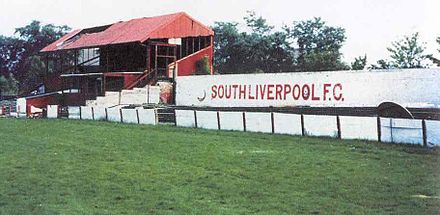 |
 |
 |
South Liverpool FC
This season I’ve been looking back at some of the old football grounds of the North of England, along with some of the founder members of The Northern Premier League. One such club is South Liverpool FC, once the Premier non league club of Merseyside. The club still exists to this day but only in the local Liverpool League. A club with the same name had existed since the late 1890’s but had no link with the club that where to be founder members of the Northern Premier League
South Liverpool FC were formed in 1935 in the Garston area of Liverpool. The population of the area was swelling and the new club had Football League ambitions. Their substantial ground with a capacity of around 15,000 was at Holly Park, now the site of Liverpool South Parkway railway station. The club joined the Lancashire Combination and achieved instant success winning the League 3 times on the trot. The club entered the Welsh FA cup in 1939 and amazingly, won it, beating Cardiff City 2-1 in the Final at Wrexham.

The club made several unsuccessful applications to join The Football League and despite their continued success on the football pitch they always failed to secure enough votes. Undeterred the club pushed on with their ambitious plans and were the first Football Club in England to erect permanent floodlights. The lights were used for the first time in a friendly match in 1949 against a touring Nigerian National team. The match was broadcast live on the BBC World Service, with commentator being the famous Kenneth Wolstenholme (“They think it’s all over, It is now !”). The match ended 2-2 in front of a crowd of 13,007. It’s said that The Nigerian team played in bare feet !!

The covered terrace opposite the main stand
In 1967 South Liverpool gained National acclaim, when The World Famous Hungarian, and Real Madrid star Ferenc Puskas, turned out in a friendly match at Holly Park in front of a crowd of over 10,000. The match had been arranged as a fundraising event for a local charity. Puskas’s team came up against Former Liverpool Winger Billy Liddel’s select 11, which included Billy Bingham, John Charles and Malcolm Allison. Puskas scored a hat trick in the match despite his team losing 5-3

(Photo courtesy of The Liverpool Echo)
In 1968 The club became Founder members of the brand new Northern Premier League, and took their place alongside the likes of Wigan Athletic, Macclesfield Town, Altrincham and South Shields. The club never managed to reach the heights of their Lancs Combination success but became able competitors in the new League.

Notable players who started their Football careers playing for South Liverpool in their NPL days, were Jimmy Case, who went on to be one of Liverpool’s most successful players of the 1980’s. John Aldridge the Liverpool and Republic of Ireland striker also started his career at Holly Park. Aldridge’s subsequent transfer to Newport County netted South Liverpool £2,500 plus a further £1,000 after so many games. This money kept the club afloat for several seasons.
In 1987, in what seems to have been a not too rare occurrence with many floundering clubs, the profitable club house was burned to the ground in a fire. This signalled the end for the club that had been struggling to compete for some years. The club soldiered on until the 1989 / 1990 season when they were forced to resign from The Northern Premier League.

Sparse crowd watching a match at Holly Park

https://www.southliverpoolfc.com/history/
Holly Park had been closed down in 1989 and rapidly fell into a state of disrepair before it eventually became the site of the South Liverpool Parkway Railway Station. A plaque today commemorates the club and in particular, mentions the night that Puskas played at the ground. ( see photo of plaque below) The legendary player never played at the City’s other famous stadiums, Anfield or Goodison Park, so that’s one up to South Liverpool.
South Liverpool FC are currently on the up and have been promoted to The North West Counties Division One North for the 2021 / 22 season. they will play their home games at the Jericho Lane Football Hub. (photo below)



The Plaque at Liverpool South Parkway Railway Station which occupies what used to be
Holly Park, home of South Liverpool FC
